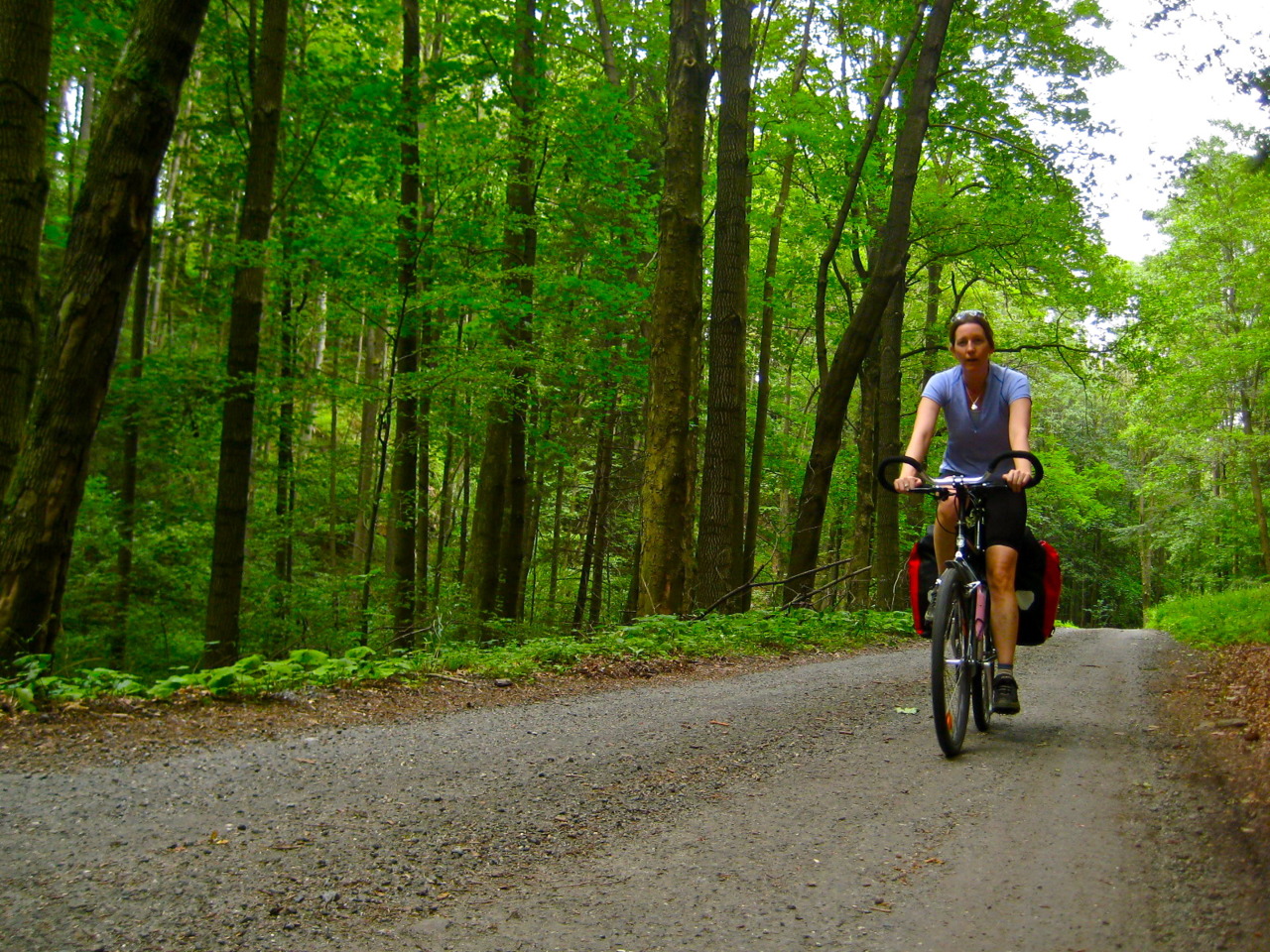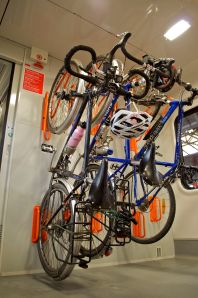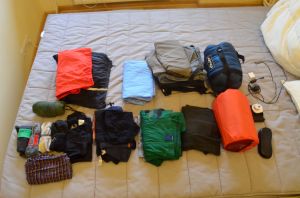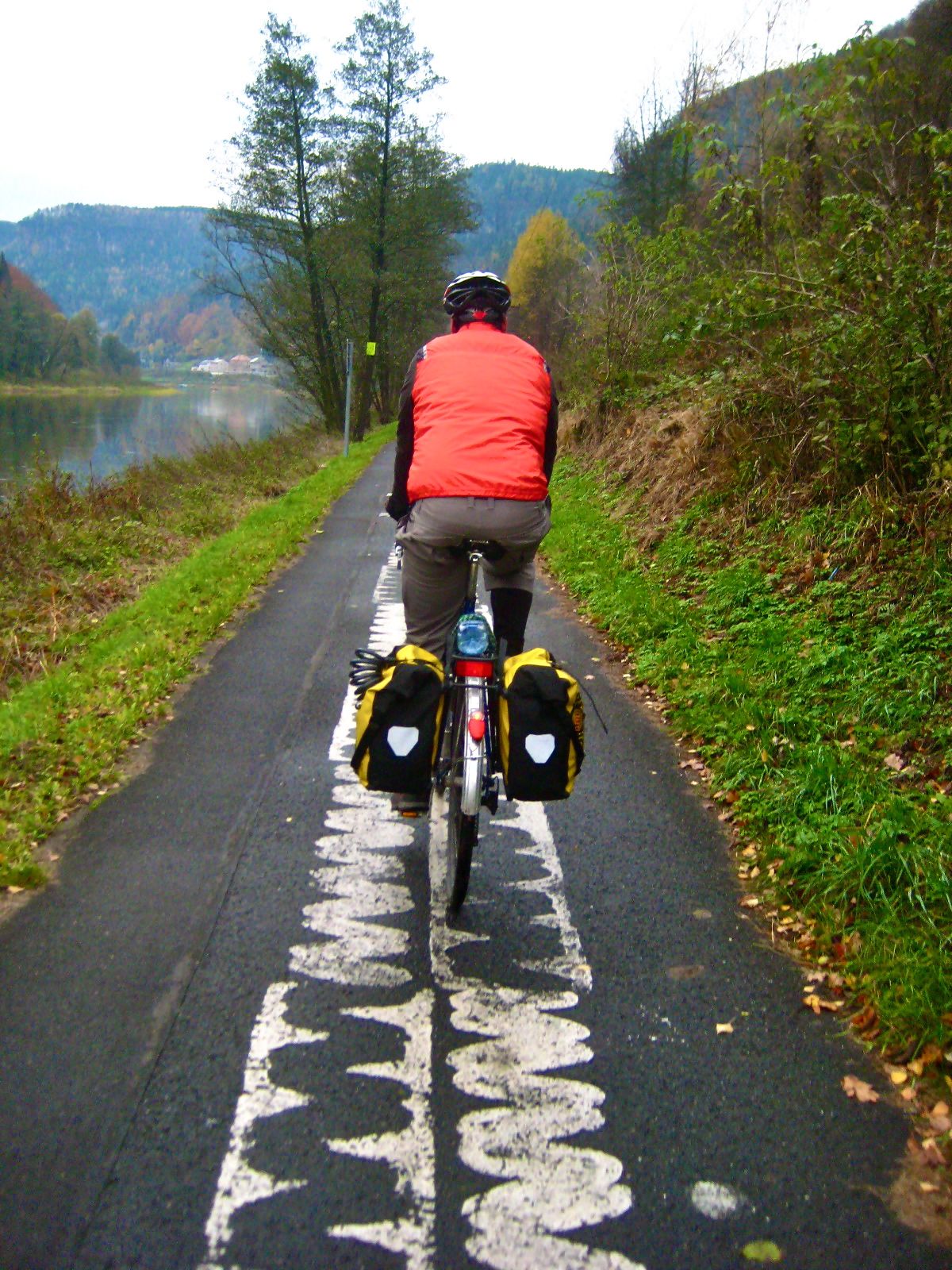Bicycle travel doesn’t have to be hardcore. You can even bring your knitting
After reading Julie Huck’s article, “Knitting Club tackles trail of the Coeur d’Alenes”, on the Adventure Cycling blog, Carolyn and I started talking about the all myths surrounding overnight bicycle travel that might keep people from actually trying it. In her post Julie shares a recent experience convincing her knitting club to go on an overnight bicycle trip. Since most of the group had never done an overnight bicycle trip, it sounded difficult and messy at first glance. The knitters were reluctant until Julie countered their arguments with easy, simple solutions. Proving to her friends that bicycle travel, even overnight bicycle travel, doesn’t have to be hardcore to be fun. Anyone can do it.
Bicycle travel is not as hard as you think
With the idea that overnight bicycle travel needn’t be hardcore to be fun we began plumbing the depths of bicycle forums, message boards, asking friends and the like to come up with the “Top 5 myths about bicycle travel and how to dispel them”.
Here’s what we found:
- You have to be a hardcore adventurer
- You need special, expensive equipment.
- Weather- It’s too hot / too cold.
- You need to be a bike mechanic
- It’s not safe
Remember as we go through list below, we are talking about beginning bicycle travel for the newbie or someone who might be an avid cyclist but has just yet to take the jump to overnight travel by bike. We want to keep the distances short and the investment in equipment minimal. This list is not meant to be the definitive bicycle tourist’s kit list nor a technical primer, but rather an introduction on how someone might try a bicycle overnight and overcome some of the myths surrounding it.
Dispelling the myths about bicycle travel
Like the example of the Knitting Club above, bicycle overnight travel doesn’t have to be hardcore to be fun.
You don’t have to go fast. You should see me. I redefine slow. I sometimes need to speed up just to stop.  Our experience tells us that some of the best places are often close by and some of the easiest trips.
Our experience tells us that some of the best places are often close by and some of the easiest trips.
Pedal at your own pace, to a destination that is within your reach. The idea is to get out on your bicycle and go someplace. Even if that place is only on the other side of town. It’s just fine as long as you enjoy it.
You don’t have to go far. One option we use regularly for extending our trips is public transit. We use buses and light rail to extend our range or cut down travel time. Check with your local Public Transit agency to see if they will carry bicycles and how they must be loaded on and off the bus or train. After that, it is as simple as picking a destination that is within your range. Remember bicycle travel is about having fun. So have fun. Go someplace on your bike. You can do it.
Bicycles. While a purpose built touring bike is great, particularly for long distance trips and multi-day adventures, it’s not required. As Carolyn pointed out in her post “Touring bike on a budget…”, it is possible to convert an old Mountain Bike to a great touring rig with a relatively minimal investment. A City Bike / Hybrid is another good option as long as your travels don’t take you too far off-road or require you to carry extremely heavy cargo. You can ride just about any bicycle that you have. What matters is that it is comfortable over an extended distance and your bike has some means for carrying cargo.
Panniers. While there is a certain pleasure in having nice touring panniers, it is not a stopper by any means. If you’re sure that bicycle travel is for you, then by all means invest in a quality set of waterproof panniers, like the Ortlieb Classic Rollers. Nothing can beat them. If you are not yet sure, or perhaps this is your first overnight its not a problem to improvise. A basket, milk crate or a book bag lashed to a rack can hold a remarkable amount of cargo if you pack creatively.

You can lash light, compact items to your handlebar and saddle.
Photo by Nicholas Carmen at Gypsy by trade
Photo by Nicholas Carmen at Gypsy by trade
You can also simply lash some of your lighter, more compact cargo, like a sleeping bag or pad, to the front of your handlebar or saddle rails. Make sure your cargo doesn’t interfere with your brakes and shifters. Nicholas at Gypsy by Trade swears by this technique and finds it superior to panniers over rough terrain as his cargo is more aligned with the center axis of the bike making it easier to handle than with panniers.
Make certain when lashing items onto your rack, handlebar or saddle that you secure these items very well. The constant motion can entice your cargo to take a tour of its own if not secured, and no one wants that.
Be prepared, but not overly so. . While we can’t offer any tips or tricks on how to change the weather while you are on your overnight bike trip we can offer some basic advice on how to be prepared for what ever Mother Nature throws at you.
Make sure you wear light, breathable clothing in hot weather and bring a hat if you’ll be out during the heat of the day. Take lots of breaks. Drink lots of water. Pace yourself. Bicycle travel doesn’t need to be a race. Relax. Stop and swim, eat some ice cream, check out a farmer’s market…this is supposed to be fun.
In cool or cold weather, bring light layers, mostly wool. Cotton is out. It absorbs moisture (sweat, rain etc…) and is heavy. A light wool sweater is perhaps the best piece of clothing I could ever think of having on a bicycle trip. In fact we almost always have wool clothing with us even in the summer, it can get cool at night. Wool is naturally water repellent and stays warm even if it’s wet and doesn’t smell after repeated use. Pack light. Remember you don’t have to prepare for arctic weather (unless you’re cycling in the arctic, and if you are, why are you reading this…?), you’ll be moving and staying warm. Bring a rain jacket with pit zips. Again, we bring this item summer and winter. You never know when it will rain.
So what do we mean about not being overly prepared? Pack light. For a bicycle overnight trip you will rarely need 2 of any piece of clothing, except socks or underwear. You won’t need as much clothing as you think.
We always use one simple rule for packing clothing: One set of clothes on the bike and one set of clothes off the bike plus a rain jacket.
Sometimes these clothes can overlap further reducing the need for extra clothes. My basic packing list for a 2-night bicycle trip is: bike shorts, underwear, 2x socks, wool t-shirt, wool sweater, rain jacket, swim trunks or shorts, hat, flip-flops. This entire load will fit in a stuff sack while riding, since I’ll always be wearing half of it at any time.
I can’t change a flat tire. Like the last point, we can’t offer any secret tricks to avoiding basic bicycle mechanics, but we can tell you this: There is no substitue for a well maintained bicycle, BUT you don’t need to know much to get started.
The basic skill needed for short bicycle overnight trips is flat tire repair. You should always know how to change a flat at the very least. The basic tool kit is cheap and easy to carry: A spare tube, tire levers and a small pump.
If you don’t know how to repair a flat ask a cyclist friend or check out the multitude of instructional videos on youtube. It’s really not hard.
Now it could be said that a well maintained bicycle is less likely to break down. No doubt. That is absolutely true. However the likelihood of a catastrophic breakdown on a short trip is less if your bike has been serviced recently. If you’re planning an overnight bicycle trip and your bike hasn’t been serviced lately it is a good idea to take it to your bike shop for a check over. After that you should be OK for short, lightly loaded touring even with a minimum of mechanical know-how.
If you plan on doing longer and more heavily loaded tours nothing beats a basic knowledge of bicycle mechanics and some crucial tools. Check out Sheldon Brown’s encyclopedia of bicycling for almost everything you ever needed to know and more.
Isn’t it dangerous? Everyone has a limit of risk vs. reward. No need to be uncomfortable or feel unsafe, but the facts are that bicycle travel is safe as long as you use common sense and follow the basic rules of the road. If you’re still unsure it doesn’t hurt to get some help, whether that is instruction and/or guided support.
- The League of American Bicyclists certifies Bicycle Safety Instruction across the US. If you feel the need, take a bike safety course. It’s a great way to get more comfortable and learn the rules of the road. The League website has a great database to help you find cycling resources in your area
- If you would like to learn more about how to safely operate your bicycle on public roadways check out Andy Clark’s book, “Smart Cycling: Promoting Safety, Fun, Fitness and the Environment”. This book covers most of the items in our list here, including rules of the road.
- The Adventure Cycling Association is the US’s largest bicycle touring advocacy group and resource. These fine folks have route maps, guided tours, forums, how-to articles and are a constant source of inspiration and information for bicycle travelers not only in the US, but for those visiting from all over the world.
- If your tastes are more international in flavor check out Bike Tours Direct. They arrange guided and self-guided tours in over 40 countries around the world, with the main focus being Europe.
There are also off-street paths that can help you get to your destination safely and comfortably. Some long, Some short. Check your local Parks and Recreation offices and Bicycle Advocacy groups to find out what is near you.
In Portland we have the Springwater Corridor, a well-used trail leading from the city center to the suburb of Boring, OR(MAP). It’s also common to combine MAX, our local light rail, with biking to get out to Stub Stewart State Park for a bicycle overnight, even with the kids. In Missouri is the famous Katy Trial, runs 237 miles across most of the state. Over half of this trail follows Lewis and Clark’s route along the Missouri River and is dotted with history and accommodations. In the East there is the C&O canal trail, which is now linked to the Great Allegheny Passage trail for a combined total distance of 330 traffic free miles from Washington DC to Pittsburg, PA. Of course none of these trails require that you ride the full distance.
Now all that’s left is to pick a destination no matter how short or long and get out there and travel by bicycle.






